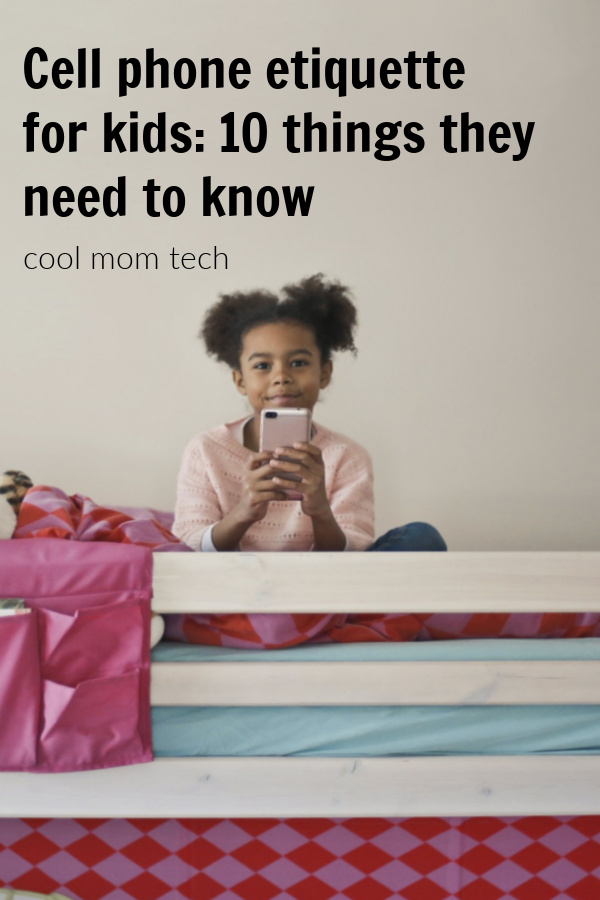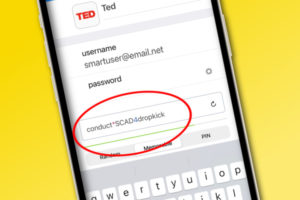After a little texting debacle between my 11-year old and her friends, I realized that maybe I wasn’t the only parent dealing with cell phone etiquette issues. And, after asking our Out Tech Your Kids group about the annoying cell phone habits their kids have, my suspicions were confirmed.
Whether you’ve got seasoned cell phone users in your house, or you’re just now thinking about getting your kids their first cell phone, here are 10 things they need to know about cell phone etiquette. Feel free to pass this post along to your friends and family. You know, for their kids. Ahem. Cough.
Related: 10 questions you should ask when writing a cell phone contract for your kids

1. Generally speaking, you answer your phone by saying “Hello.” My mom used to make me do this long, drawn-out speech when I was growing up on our landline phone, and I take every chance I can to tell my kids that story. These days, I’m pretty sure just saying “HELLO” is enough. Or Hello NAME OF PERSON since there’s also called ID. This may seem obvious, but if you’ve gotten a “yah?” or “bruh,” then… maybe it’s not.
2. Texting before you call someone is now a thing. (And I like it). Even though kids rarely call anyone these days, it’s a good thing for them to know that it’s good etiquette to text someone before they call to see if they’re available, especially a Facetime call. This will hopefully avoid my next rule: SPAMMING.
3. If someone is not answering—texts or calls—do not continue to text or call them. Apparently, my daughter has an agreement with her friend that “spamming” is fine, but otherwise, it’s not cool in my book. That applies to their friends and adults too. If you text once or call once and someone doesn’t respond, that means they are not available to talk or text with you. The end.
4. Get permission before adding someone to a group text or group call. This one might be tough considering it seems to be pretty commonplace for kids to just add other kids to group texts and calls without their permission, but I’d still reinforce this rule. A simple “Can I add you to this group text or call?” is something they should learn how to type, and be ready to accept the “No thanks” that might come their way. That leads me to my next rule.
5. Be comfortable with saying “no thanks.” (And if they need a reason, let them blame you). Kids should feel comfortable saying “no” to being added to texting threads, group chats, or calls (group calls or group Facetime calls), and feel comfortable leaving if they don’t want to participate. If they are worried about the reactions some kids might have, give them permission (which I do for any sort of hard social situations where their safety might be at risk) to blame you. “My mom said I can’t group chat.” or “My parent said I can’t use my phone right now.”
6. Text in full complete thoughts and sentences. At least to adults. Goodness. How many times have you gotten just “MOM” with nothing else? Or Mom 30 times in a row until you answer? (See #2). I realize that they have different rules about texting with their friends, but it’s a good idea to get them used to sending complete thoughts (and sentences) whenever possible.
7. Respond to a person when they text you. If they can answer in an emoji, that’s fine, or even just liking or hearting the text, but we have a rule that kids must acknowledge text messages from other people, even if it’s “I’m sorry, I can’t reply right now.”
Related: How to raise a good digital citizen: 4 things they need to know
8. Make sure they understand tone in texting. It’s way too easy for tone to get lost in texting, so teach your kids how things can be easily misconstrued, especially if they’re in a hurry. Heck, I know I have had text messages land poorly when I wasn’t quite focused on the words I was sharing.
9. With that in mind, texts are forever. Make sure they know that. Even Snaps. But definitely texts. If they don’t want that text read aloud at school in front of all the kids and the parents, then they shouldn’t be texting it. This is a hard lesson to learn, even for adults, but it’s an extremely important one.
10. Be kind. This is basically my life rule, but it applies to texting and calling, as well. If you’re not in a good place to text or call, just don’t do it. It’s perfectly fine to say “I’m not able to text or talk right now.” Or whatever feels the safest and best to share with their friends or other adults. But any words they’re using should come from a kind place.






